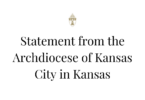Community helps Emporia students veg out
by Joe Bollig
joe.bollig@theleaven.org
EMPORIA — Concerned nutritionists have been pleading for years: Give peas a chance. One school is doing this . . . and more. Canned? Frozen? Fuggedaboutit. They’re growing their own veggies. Broccoli and school spirit, anyone?
And what began as a simple proposal for a little garden at Sacred Heart School in Emporia has grown into a project to promote learning, healthy eating, parish unity and community involvement.
“I started asking questions about how we could improve our lunch program by getting more fresh, locally grown, organic and sustainable food in the school,” said Father Richard Warsnak, pastor of Sacred Heart Parish. “We started with discussions about that, and it moved into reaching out into the community.”
Originally, the idea was to build a raised bed garden, but the idea grew into the creation of a type of greenhouse called a “high tunnel,” also sometimes called a “hoop house.” These are long, semicircular structures that feature a frame of plastic covered with plastic sheeting. It works by trapping solar heat and thus extending the growing season.
Critical to the launch of the project has been Bill Hanlon, director of Green Building & Sustainable Development Center at the Flint Hills Technical College in Emporia.
“I called [Bill Hanlon] one day and asked if I could meet with him,” said Father Warsnak. “He’s an area expert in sustainable living. So I set up a meeting with him and Linda Glaser, a fifth- and sixth-grade teacher [at Sacred Heart School], who is very passionate about these things.”
Hanlon offered his technical expertise and more. He helped the school pay for the high tunnel greenhouse by getting a grant from the Kansas Department of Health and Environment and procuring the materials to build the structure.
“Our cost [of the project] was in getting the volunteers to help build and run it,” said Theresa Lein, principal of Sacred Heart School. “We have no major out-of-pocket expenses for this project.”
The school began building the 20-foot-by-60-foot tunnel, located on the school’s south side, in mid-October. The first workers were Father Warsnak, Hanlon, Glaser, and other teachers, parents, and community volunteers. Another person who has helped quite a bit is Gary Janssen, a retired organic farmer.
“We got a great response from people in our community, almost immediately, wanting to help us,” said Father Warsnak. “They understand the impact we have on our local community and the environment through our eating.”
“And it seems to fit very well with our Catholic theology and understanding that we are tied very closely together with God’s creation,” he continued. “There’s a moral imperative that we do better with these things.”
The school’s 63 students helped put up the sheet plastic in early November. The remaining work will be building the “ends” to the structure, the raised beds, and the planting tables. Planting could begin as early as February of next year.
“What I have been told is that we can grow produce 10 months out of the year,” said Lein. “We’ll begin planning cold weather vegetables in late February — lettuces, peas, radishes. As spring comes, we’ll put in summer crops. Apparently, we’ll have produce almost up into December.”
The food grown in the high tunnel will be used in the school’s kitchen. Good nutrition, however, is not the only benefit from the garden.
“The students are very excited about it,” said Glaser. “They’ll help choose what kinds of plants we’ll grow. They’ll help plant, weed, water and harvest, and hopefully get involved in some of the food preparation.”
The children will help make the organic soil for the high tunnel by making their own compost. By growing and composting, the students will get a scientific education about how plants grow and about soil, she said.
“The students love it,” said Father Warsnak. “They’re very, very excited. It’s cool that they’re excited about fruit and vegetables. They very much want to be part of this.”
It’s still too early to say whether the community will enjoy any long-term benefits from the efforts of the Sacred Heart program.
But Father Warsnak’s betting that it’s at least a step in the right direction.
“When kids have a hand in growing the food, they want to eat it, too,” he said.
“It tastes better to them.”






